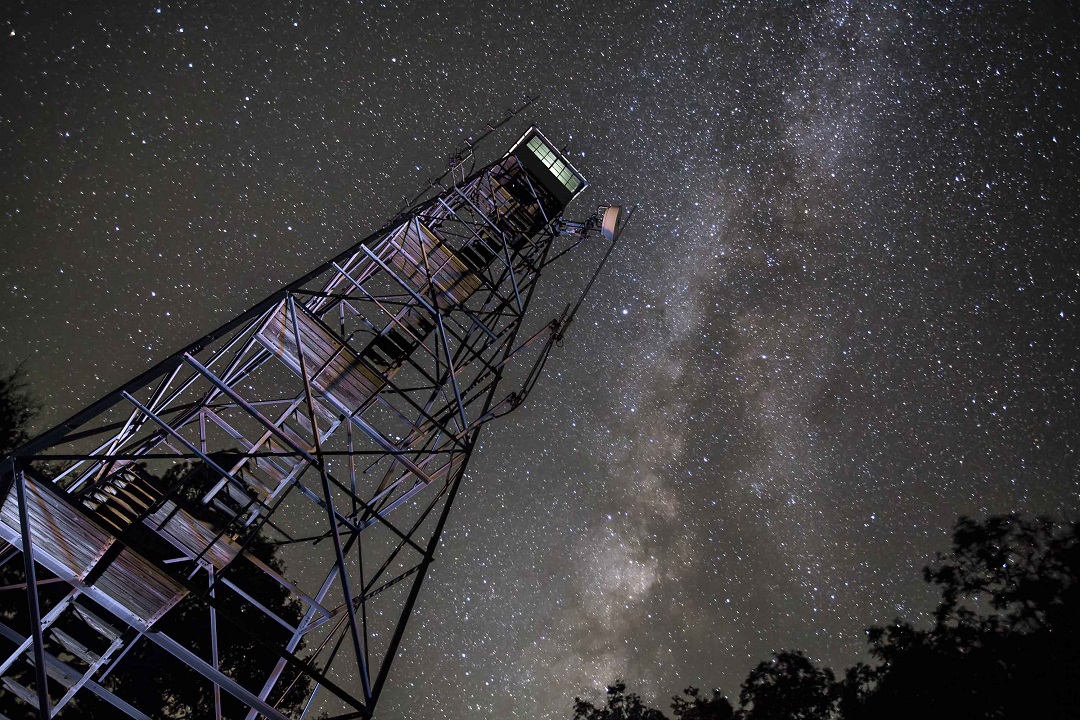It’s cold. It’s dark. No better time for a hike — at least for those who prepare.
Gazing up at the Milky Way, navigating by the constellations, and adjusting to the light of a full moon leaves you vulnerable but opens you to rely on your other senses. Trust your planning, and Mother Nature will share a few secrets and deepen your connection with the outdoors.
“I think it’s cool because it gives you a different perspective of a trail you’ve been on before, just like going in a different season or hiking in the opposite direction,” said Dan Zarlenga, the Missouri Department of Conservation’s media specialist for the St. Louis region. “It feels different. You don’t have as much visual stimulation, so your hearing becomes more acute. Even in the fall and winter, you can hear coyotes, owls, and deer. There’s a lot of opportunity for focusing on your other senses.”
Zarlenga also enjoys night hiking to indulge his hobby of photography. “It’s a whole new world and a totally different discipline,” he said.
But night hiking takes extra discipline and preparation to enjoy fearlessly. Here are a few suggestions for meeting the challenge and enhancing the experience.
- Hike a familiar trail or visit first in the day to get the lay of the land. “The sense of security could give you one less thing to worry about,” Zarlenga said.
- Choose level, open trails. Avoid trails with sharp drop-offs. Open glades also are better illuminated by star and moonlight than trails in the forest and tend to be flatter.
- Savvy night hikers time their treks to start at sunset, which gives their eyes time to adjust as the sky darkens. Zarlenga suggests trying this when the moon is full — within a day or two of the Beaver Moon on November 8 or the Cold Moon on December 7.
- Bring a light or two, preferably a headlamp. “[Headlamps] free your hands to help with navigation,” Zarlenga said. Minimize turning the light on and off, which forces your eyes to adjust each time. Some headlamps include a red light setting; night vision is less effected by the longer wavelengths of red light. And do your best not to shine your lamp directly at others.
Use a walking stick or trekking poles for help in locating and maneuvering around stumps and rocks. - Adjust your speed and distance. Zarlenga advises cutting expectations in half or by two-thirds. So, if you hike 3.5 miles an hour in daylight, expect to cover about a mile and a half in the dark. “A mile at night seems a whole lot longer than a mile in sunlight,” he said.
- Bring GPS or a map and compass. “If you get turned around,” Zarlenga said, “and, trust me, I’ve done it, they’ll help you get your bearings.” Even on a familiar trail, the visual cues are missing or difficult to spot. And you might be so absorbed in moon shadows and the chorus of wildlife song that you miss trail markings.
- Dress in layers and bring water. Reverse the procedure for day-hiking, when you tend to shed clothes. And you can still get dehydrated in the cold.
- Buddy up. When you’re alone, one slight trip, creepy shadow, or unfamiliar hoot can turn your mind into your worst enemy. Take a friend or two to keep you from jumping to the wrong conclusions. And always let someone know where you’re hiking.
If you’re more comfortable in a crowd, the Missouri Department of Conservation’s group hikes at August A. Busch Memorial Conservation Area are a good place to start. Two night hikes at Busch are scheduled from 5:30 to 8:30 p.m. on November 26 and December 17. Events are added frequently, so check the conservation department’s events page at mdc-event-web.s3licensing.com/Event/AllEvents?EventTypeId=15.
November 19 is National Take a Hike Day. With a little preparation, though, you could extend the celebration after dark and under the stars.
Night Hike Trails to Consider
- The Lewis and Clark trails at Weldon Spring Conservation Area. Portions overlook the Missouri River. Some stretches are steep and forested, so it’s best to be familiar with the trails before hiking at night.
- Danville Conservation Area near New Florence, which features open sections where it’s easier to see impediments and navigate using stars and the moon.
- Valley View Glades and Victoria Glades conservation areas, both in Jefferson County.
All the trails above are open until 10 p.m. Zarlenga adds that any of the conservation areas that are open for camping also offer night hiking, though he stresses checking ahead for closures due to weather or maintenance.
- Rock Hollow Trail, a 2.3-mile stretch of asphalt in Glencoe, connects to the Al Foster and Bluff View trails as well as a pair of single-track, natural-surface trails known as Zombie East and West. (Seems perfect for a night hike because…zombies.) Managed by the Missouri Department of Natural Resources and the city of Wildwood, the trails are open until 10 p.m.
Author: Kathleen Nelson is a regular contributor to Terrain Magazine.
Photo: Stegall Mountain Fire Tower in Shannon County, Missouri, by Dan Zarlenga.


SIUE Trails are great at night and can be mixed with the cross country course:
https://gorctrails.com/trails/siue-trails